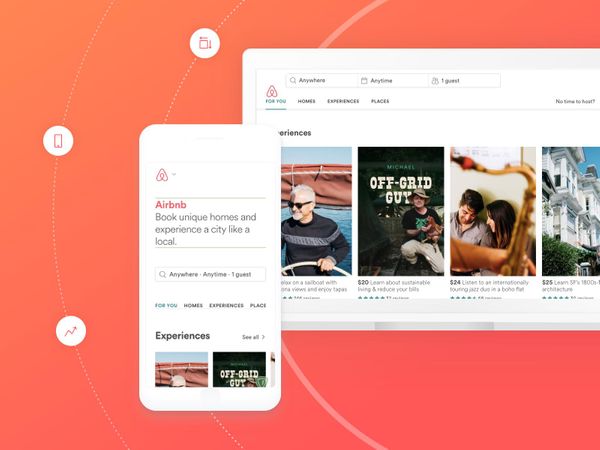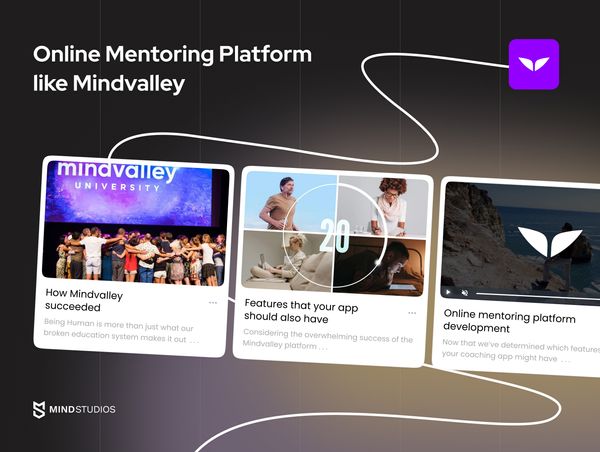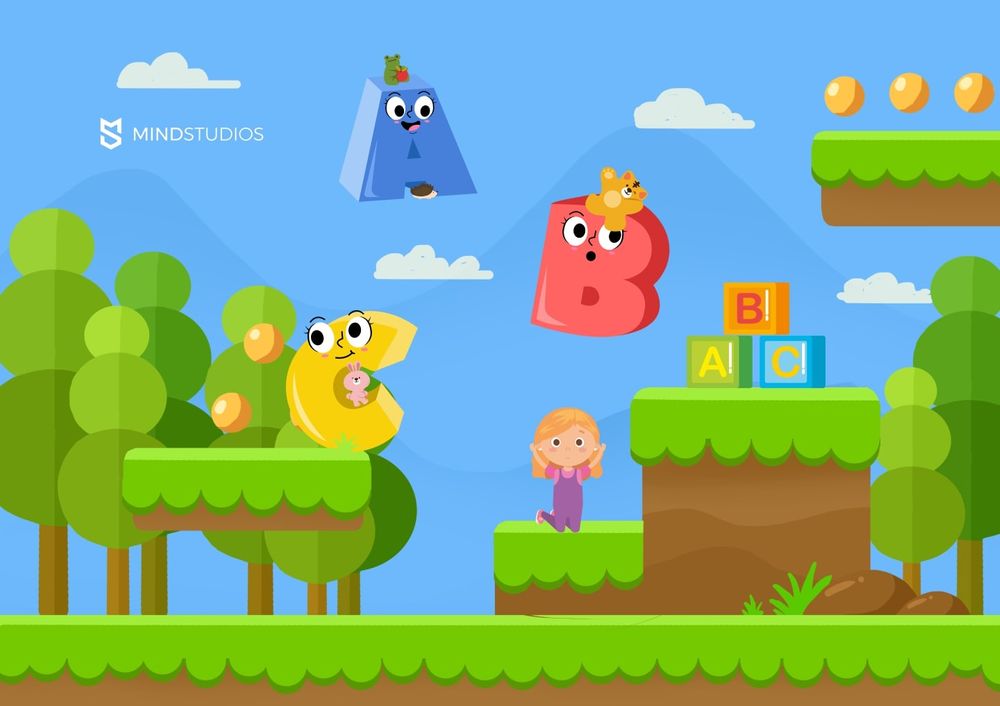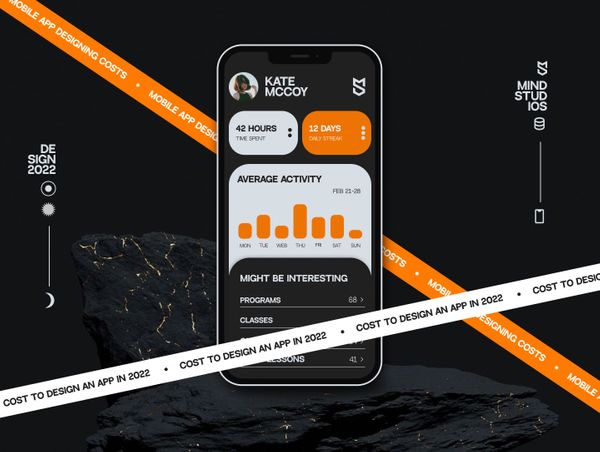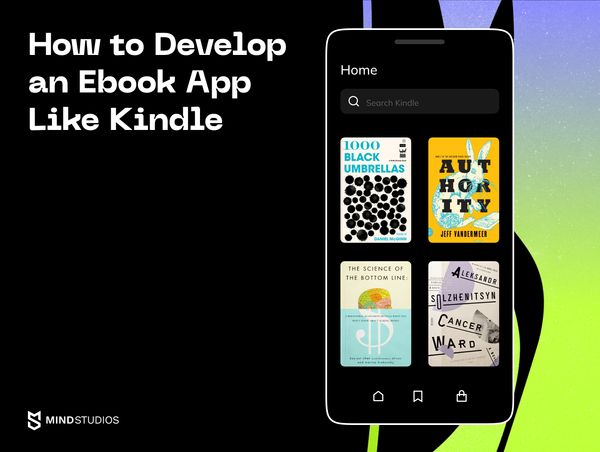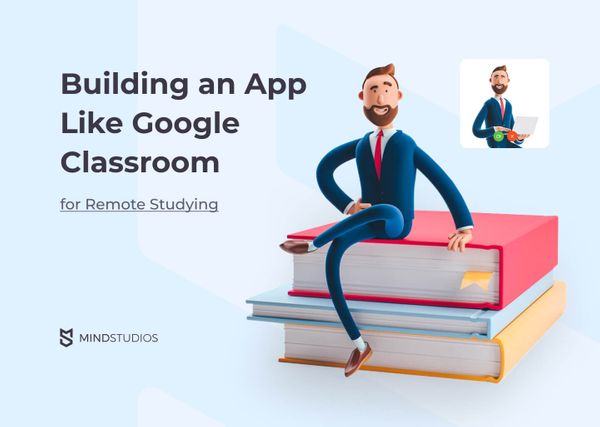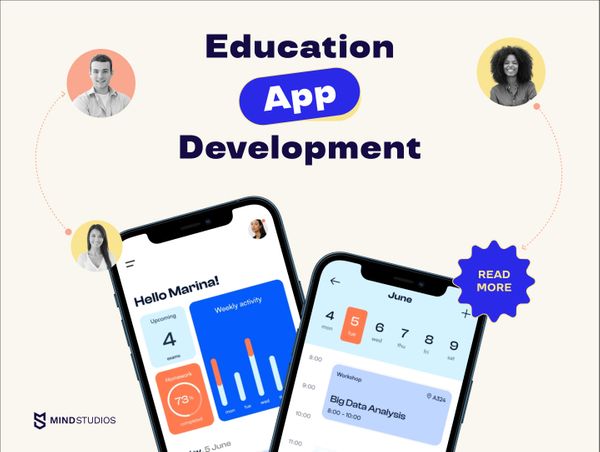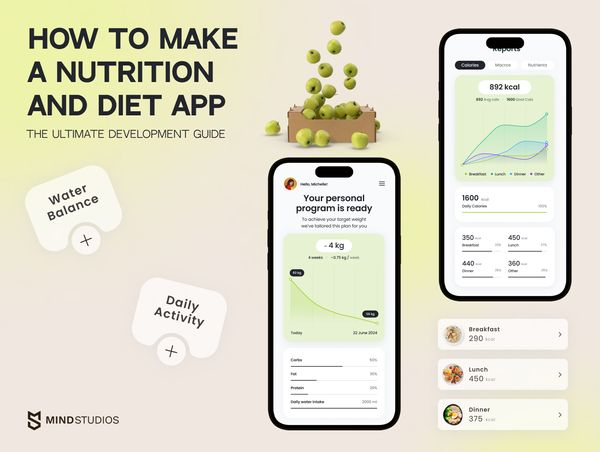
Launching a unique e-learning website in 2024 is both an ambitious challenge and a smart investment. In a modern world, education has exceeded the scope of conventional schools and universities. Lifelong learning is now an integral part of succeeding in life, and numerous online platforms make education of all kinds more accessible for people from all corners of the planet.
So, whether you want to build an online learning platform for teenagers, a website to enhance your employees' expertise, or something entirely new — congratulations, your idea has high chances of being in high demand. Now, your key tasks are conducting a thorough research to shape this idea into a solid plan, and finding the right development team.
In this article, we provide the ultimate answer to the question of how to make an e-learning website while avoiding pitfalls and taking current trends into account.
E-learning platform market overview
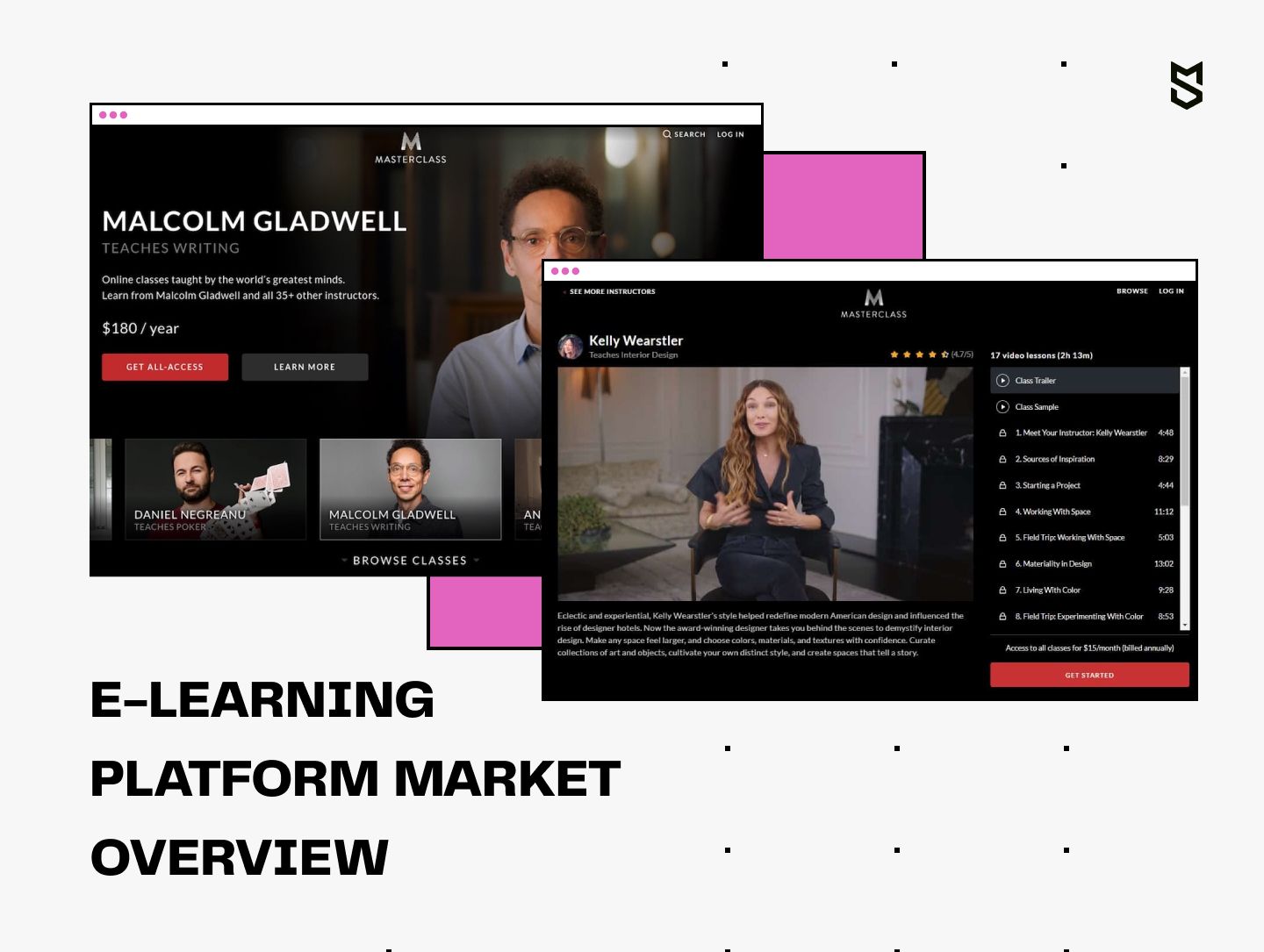
“When I wanted to learn something outside of school as a kid, cracking open my World Book encyclopedia was the best I could do. Today, all you have to do is go online.” — Bill Gates
We are willing to bet you have taken at least one course on Coursera, a platform with over 100 million registered learners, or Udemy with 46 million users. However, the popularity of MOOCs — massive open online courses — does not mean educational startups do not stand a chance.
One of the vivid examples of remarkable success in the field is GoStudent, an online tutoring platform. Founded in 2016 in Austria, this service allows school- and college-aged students to find tutors in 30+ subjects and have one-to-one video lessons. In the last five years, GoStudent has experienced a 9800% search growth, expanded to over 20 countries, and is now valued at $3.5 billion.
Felix Ohswald, GoStudent co-founder and CEO, states that the company believes there is a big opportunity to transform how students learn all over the world by expanding access to quality education.
Making extremely valuable information accessible to anyone with an internet connection is probably the greatest thing about e-learning platforms. A few decades ago, the possibility to attend music lectures by a Beatles' member would be beyond belief. Now, with a MasterClass subscription you really can learn to drum with Ringo Starr, listen to lectures on storytelling by Neil Gaiman, or even dive into space exploration with a real astronaut, Chris Hadfield. No wonder, MasterClass managed to triple its valuation in 2021 — it literally makes its users’ dreams come true.
In addition to online courses and lessons for students, e-learning platforms are becoming a powerful tool for those companies who want to make sure their employees continue growing as professionals. Learning management systems are the type of platforms that are suitable for employee trainings, as they often include mentoring, coaching, and communication features. For instance, Orblogic is an online HR software which gives its users the option of building custom courses for their teams using videos, PDFs, digital presentations and other tools. It also allows tracking the employees’ progress and course completion. The main goal of such systems is to reduce time and other resources spent on onboarding and regular trainings.
If these examples have not fully convinced you that it is worth a try to create your own e-learning platform, here are a few remarkable facts about the impact of online education supported by numbers.
- E-learning market size is expected to reach revenues of over $388 billion by 2026 (Arizton)
- 93% of companies around the world plan to adopt online learning (Finances Online)
- E-learning can improve productivity in the workplace by up to 25% (American Heart Association)
- 42% of companies who use e-learning report increase in revenues (Tech Jury)
- 81% of college students say that e-learning has helped them improve their grades (McGraw-Hill)
So, now that we’ve established that e-learning is on the rise, let’s find out more about the specifics of educational platform development.
Types of e-learning platforms
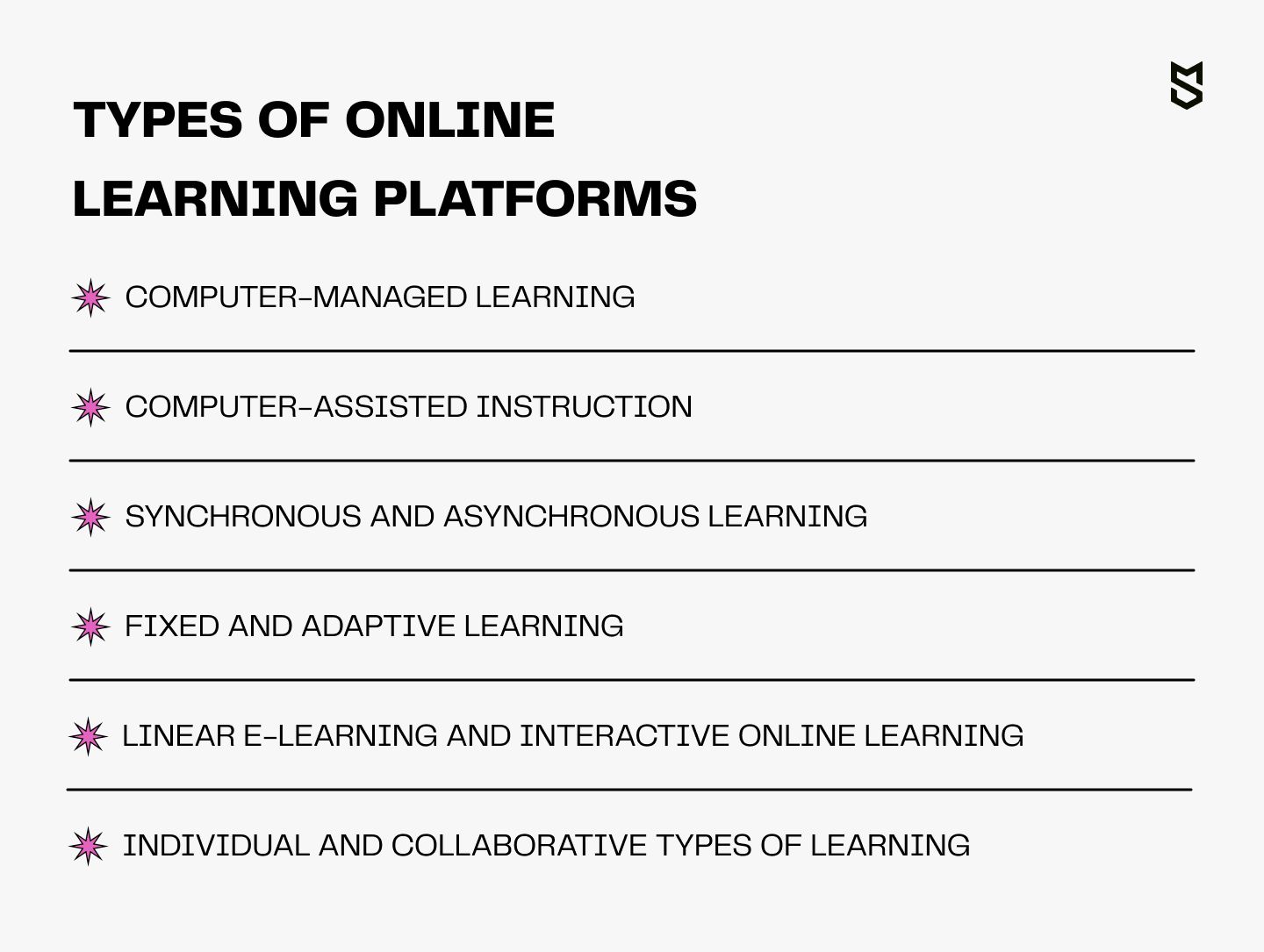
The type of platform you’re going to build is something you should decide on before starting eLearning website development. Let’s find out the main types of online learning platforms.
By the type of online learning the platform involves
Computer-managed learning are systems typically used by colleges and universities to help students study remotely. They provide educational information databases as well as studying strategies for individual students and groups.
Computer-assisted instruction is a combination of e-learning and traditional teaching, used in most modern schools and universities. Usually, this means using interactive software, for instance, video and sound tools, to make the learning process more engaging and therefore more effective.
Synchronous and asynchronous learning, the first one meaning that students may participate in the learning process simultaneously with the group while using online chats, video calls, and other communication tools. And vice versa, asynchronous learning means the students study independently and therefore are more flexible in terms of scheduling.
Fixed and adaptive learning differ by the extent to which students’ individual needs are taken into account. With fixed e-learning, the information is the same for all participants, while adaptive online learning is more personalized. The latter approach allows adjusting the learning process to each student’s goals, performance abilities, etc.
Linear e-learning and interactive online learning differ in approach to communication within the educational process. Linear method means that the students can simply receive information without the opportunity to reach out to the teacher. Vivid examples here are lessons via television or radio. Interactive e-learning encourages two-way communication and provides all the necessary tools, like chats or online meetings.
And last but no least, there are individual and collaborative types of learning, which directly depend on whether the students work towards their educational goals independently or as a group.
By the systems they are based on
Learning management system
The learning management system (LMS) is the most wide-spread type of e-learning platforms. Such websites enable the development and deployment of educational content and can automate such functions as enrollment, reporting, documentation, evaluation, and administration while being a secure storage for all data.
LMS market is popular not only with educational institutions, but also with the companies whose executives want to computerize onboarding and training processes for employees.
Examples of LXP platforms: Canvas LMS, TalentLMS, Google Classroom.
Learning experience platforms
Learning experience system has recently emerged as a new approach to e-learning, LXPs are a more user-friendly, engaging and intuitive version of learning management systems. The content there is more adaptive to user’s interests, needs, and position if used for employee training.
Such systems also offer more profound analytics, and therefore, provide users with additional information about the quality and effect of the education content so that the creators can improve it.
Examples of LXP platforms: LinkedIn Learning, EdCast.
Massive Open Online Courses (MOOCs)
The main idea behind this type of platforms is engaging as many students as possible and making high-quality education accessible. Sometimes, MOOCs can even be free of charge, or allow students to choose a free or a fee-based option depending on whether they need to get a certificate after completion.
MOOCs provide easy, no-admission access to huge amounts of educational content. As a result, platforms like this allow people of any age, occupation, location, and time resources to study and strengthen their professional skills.
Examples of MOOCs: Udemy, Coursera, edX.
Custom-build platforms
If your idea for an e-learning platform doesn’t fit any of the mentioned above characteristics, you might need a custom-built solution. In this case, the hired team will create the platform to meet the specific requirements, goals, and users of your business or institution. Mind Studios has all the resources to implement your idea from scratch, starting with conducting a market research to launching an online learning platform of impeccable quality.
Example of custom-built e-learning platform: Harvard Business School Online.
Create an e-learning website or mobile app — which way to go?
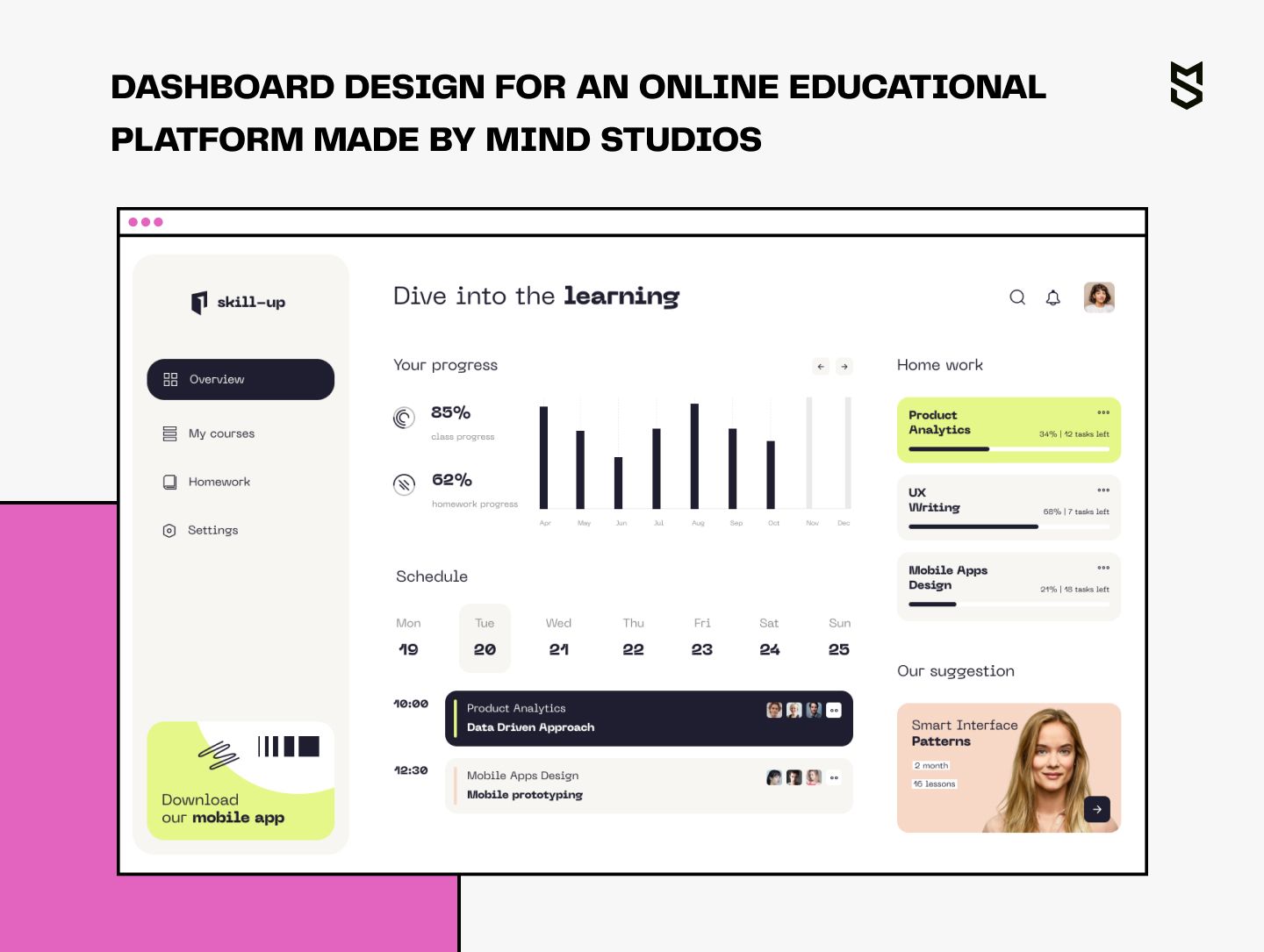
[Source: Dribbble]
A decision between a website and a mobile app totally depends on your target audience. Statistically speaking, mobile learning is on the rise. Facts and Factors predicts by that the mobile e-learning market will be worth $374.3 billion by 2026.
Among many advantages of choosing e-learning application development is the ability to:
- work offline
- upload content faster
- improve engagement
- implement gamification and interactive elements easier
You can find out more on how to create an e-learning app in our article on education app development.
However, keep in mind that if your platform is going to allow users to create their own courses, you most probably will need to build a web version. This will make it easier for tutors, company executives and other content creators to edit their courses, add tests, manage their students’ or subordinates’ progress, and so on.
Must-have features of the e-learning platform
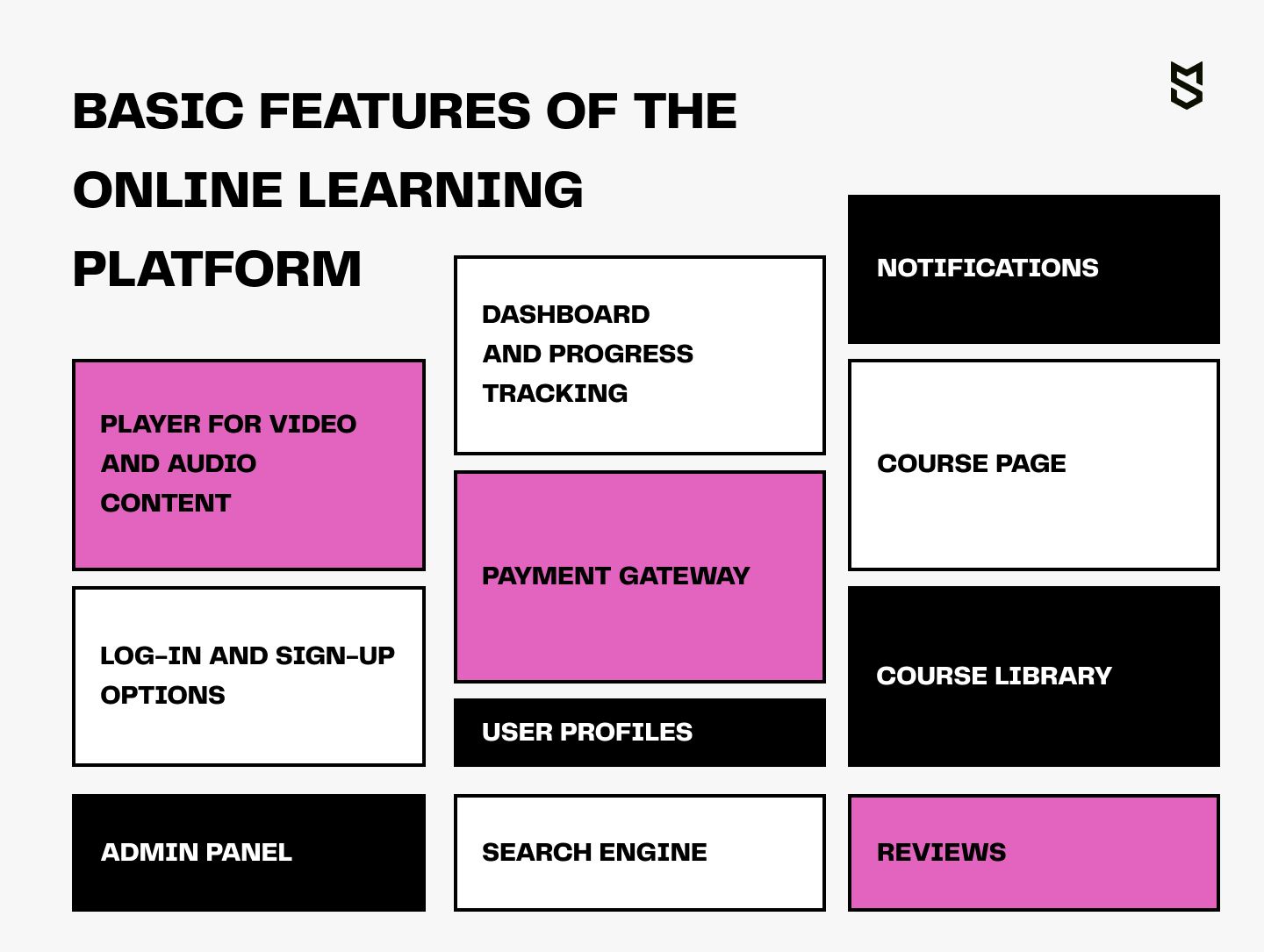
Regardless of the type of e-learning platform you want to build, there are a number of basic features your website should have:
- log-in and sign-up options
- user profiles
- dashboard and progress tracking
- payment gateway
- course page
- course library
- search engine
- player for video and audio content
- admin panel
- notifications
- reviews
However, if you aspire to win over users of your competitors, these features are not enough to do so. We’ve created a list of useful e-learning website features that will make your platform more appealing to prospective users.
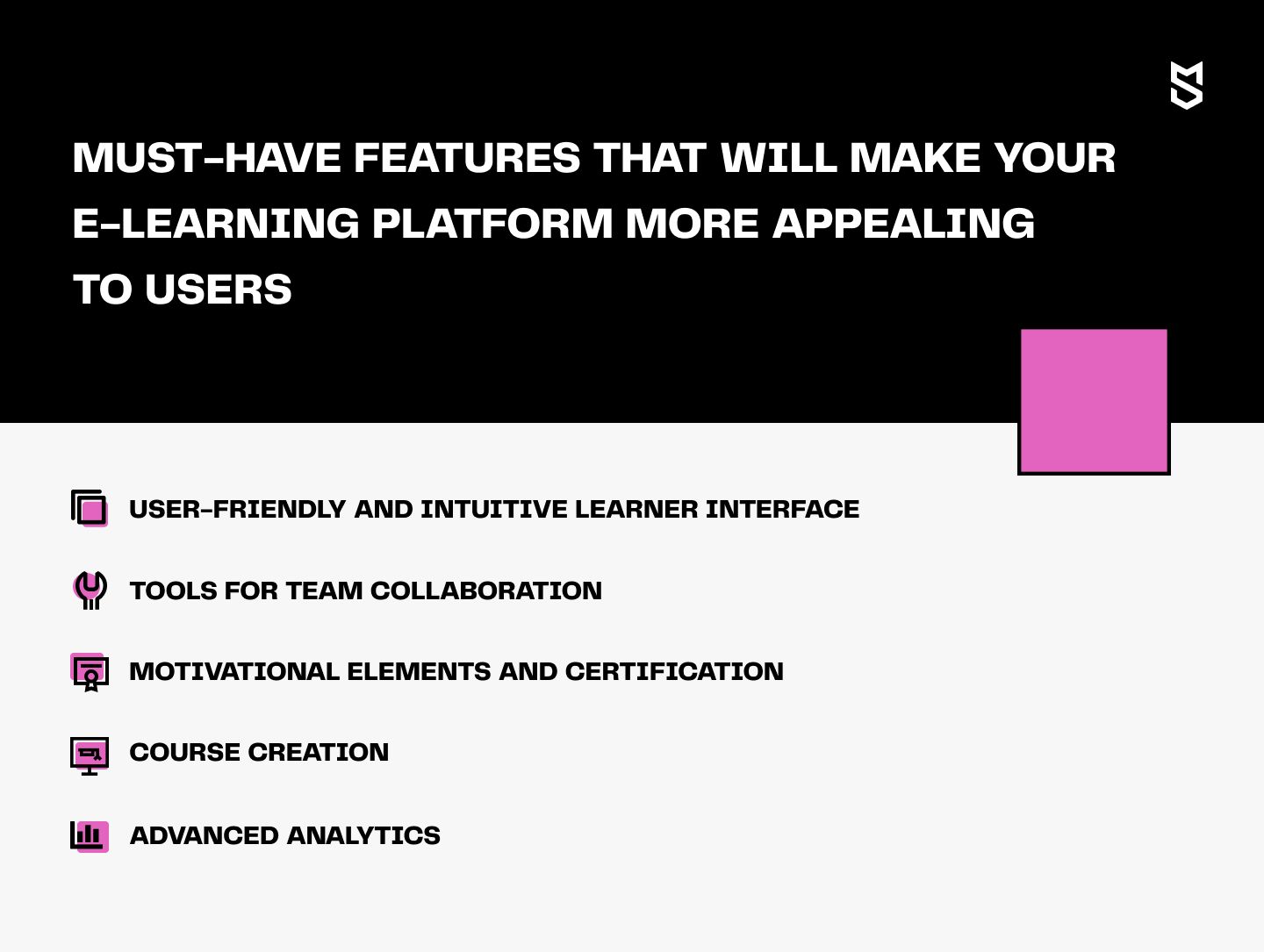
-
User-friendly and intuitive learner interface
This means your e-learning platform should be easy to navigate and to find necessary information within a few clicks. The users should focus only on educational tasks, not how-to-use-this-website issues. -
Tools for team collaboration
Studying remotely doesn’t mean both learners and teachers don’t need to communicate. On the contrary, such features as digital whiteboards, forums, chats and video conferencing, and an option to share files will increase interactivity, make the learning experience more personalized, and help to build a united learning community. -
Motivational elements and certification
Rewards system, progress bars, free access to premium features for users with the best score — all this can encourage students to keep using the platform. The most powerful motivational tool, however, are certificates. Some e-learning websites and apps even offer students to get a certificate verified by real universities or professional organizations. Whether it’s a platform for students or employees undergoing training, certificates often up the chances of learners successfully completing the course. -
Course creation
Surely, you may want to start small and base your platform on your own educational content. However, if you intend to engage numerous tutors to use your service for their own courses, you will need to provide easy-to-use course creation and course management features, such as working with a schedule, managing study groups and so on. -
Advanced analytics
This feature is key for further development of your platform and the courses it provides. Tracking learners’ journey, analysis of the average learning time, feedback from the users who have completed the course, statistics on drop-outs — these features will help you (or tutors who use your platform) improve the courses before the next enrollment. Advanced analytics is key for further eLearning portal development and the courses it provides. -
Additional features adjusted to your target audience’s needs
When deciding on e-learning platform features, we also recommend taking into account the needs of different types of users.For instance, teachers or managers will require the option of class scheduling, creating and managing their courses, overviewing students’ progress, etc.
Students, on the other hand, might need a planner, an option to take personal notes, and collaborative features to share information. Another useful feature is video and audio speed controller or the option to quickly flip through screenshots with the most essential information from the course.
If your service is for school-aged students, you can also create an option for parents to track their children’s progress and communicating with the teachers.
While creating website functionality, keep in mind that the design of your e-learning platform will not only affect the cost to develop it, but is also key to providing users with the best studying experience possible. Therefore, it is worth taking the e-learning platform design seriously.
Advanced features for an e-learning website
Now that we’ve covered the basic e-learning system features, let’s explore the more progressive trends that can up the chances of your app’s success.
Artificial intelligence and machine learning
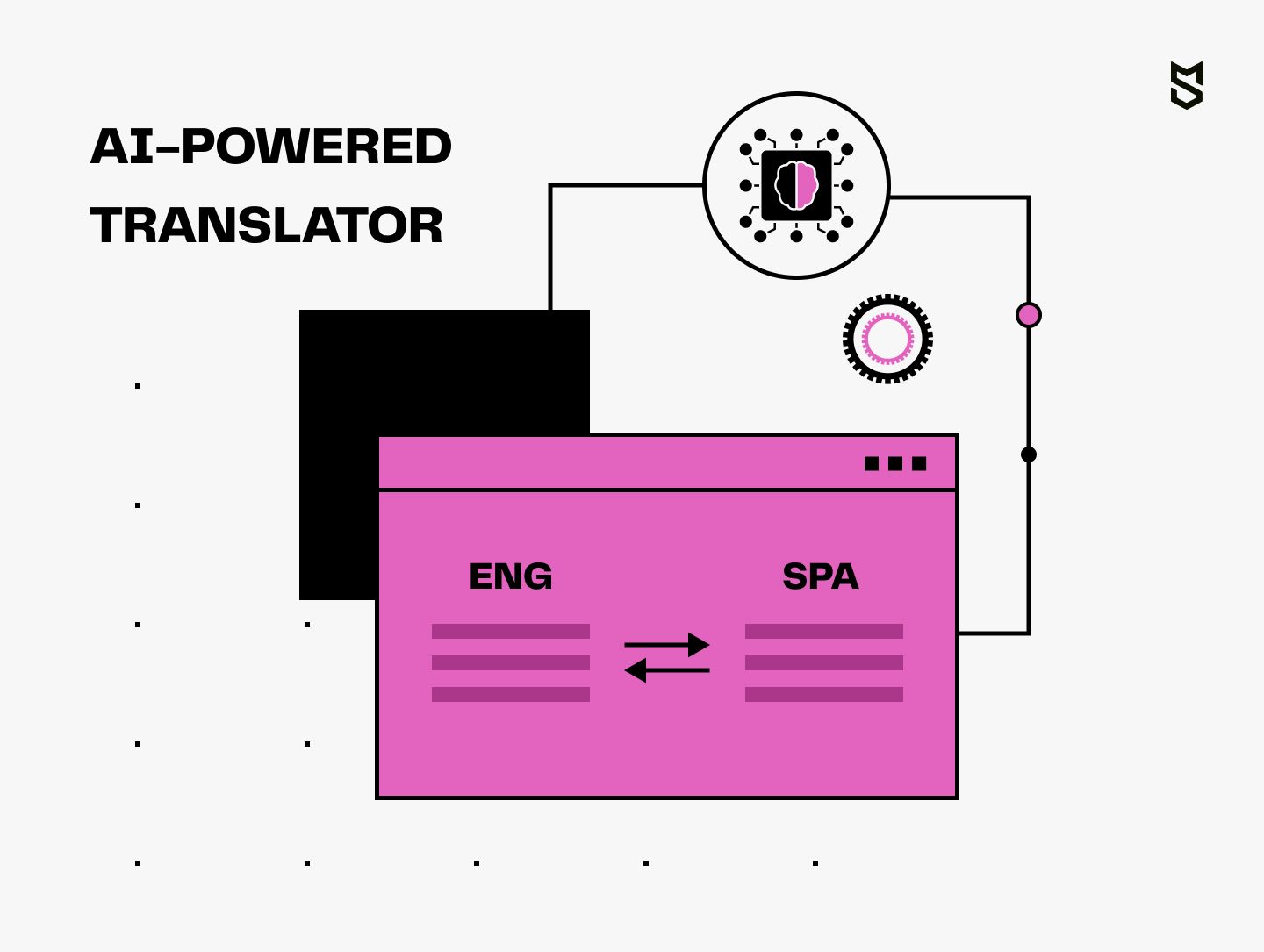
Personalization of user experience is becoming the number one trend in many business fields. Artificial intelligence and machine learning is what helps e-learning platforms to adapt to users’ needs.
Despite the common misconception, AI and ML are actually not synonymous. Artificial intelligence are computer systems that deal with tasks associated with human intelligence, such as voice recognition or translation. Machine learning, on the other hand, is connected to mathematical models aimed at processing data.
In a nutshell, both AI and ML features of e-learning systems process users’ behavior to suggest the best learning solutions for each learner and provide a captivating experience. Among common e-learning AI/ML solutions are real-time chatbots, machine translation, personalized textbooks, and advanced analytics of student performance.
Gamification
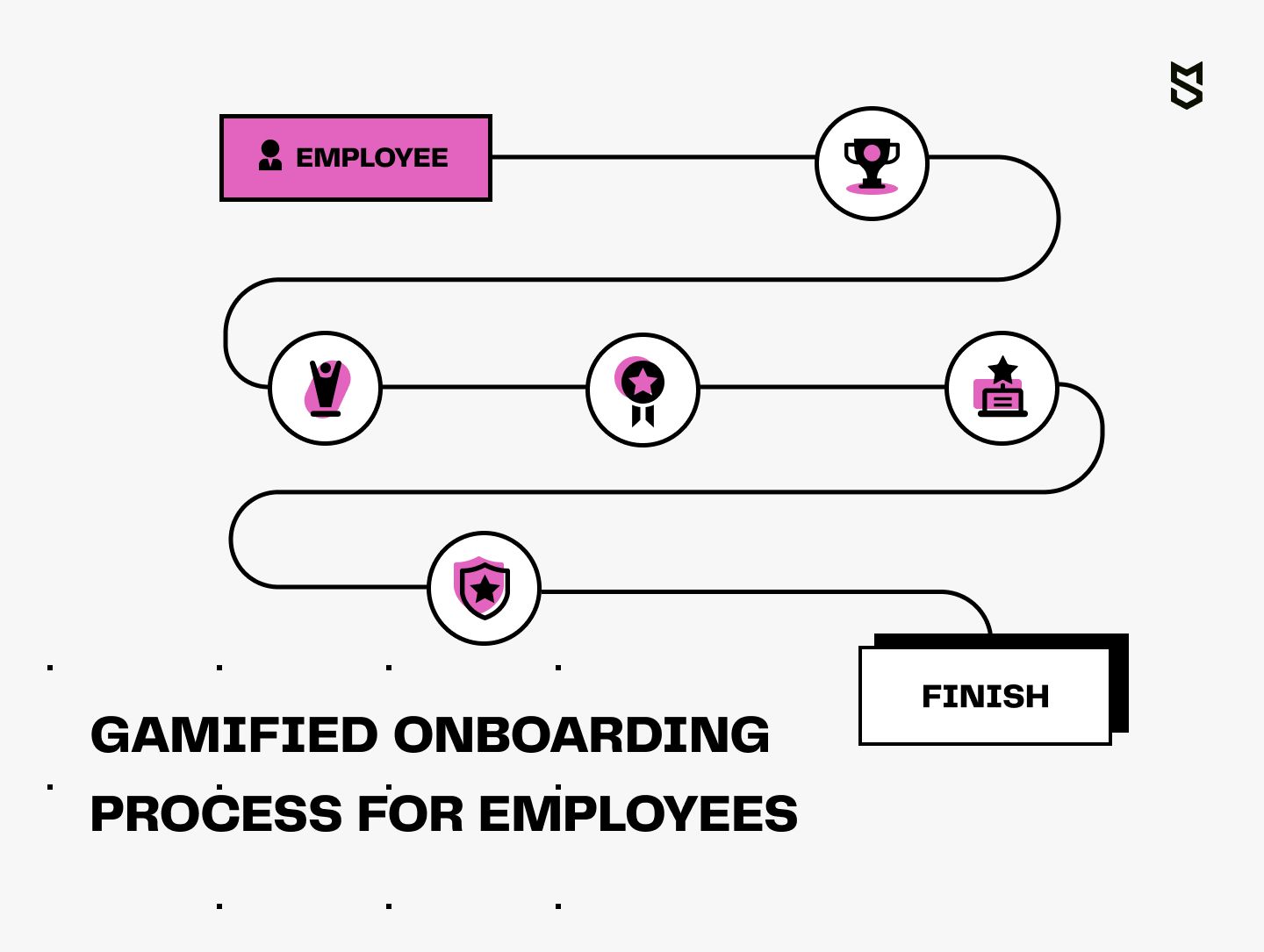
The main aim of this trend is to make the learning process both fun and effective, which, therefore, makes it more appealing to the platform’s users. You can’t deny that one of the secrets of Duolingo’s popularity must be that green owl who constantly encourages users and transforms learning languages into an exciting quest with various leagues and awards.
Despite the common misconception, gamification is equally effective among those for whom e-learning is a hobby, as well as for professionals who use such platforms to enhance their expertise. Gamified training is widely used at Google, Spotify, and other tech giants. Moreover, according to research by McQuaig in 2021, 54% of newly hired employees were highly productive because of gamified onboarding. Such trainings also improve productivity and even contribute to creating a better workplace environment. So, whether your target audience includes first-graders or adult experts, it’s worth making gamification a part of your platform.
Augmented & Virtual Reality
The difference between these two technologies lies in the fact that VR lets users to completely immerse in the created reality, while AR overlays digital elements over the real world around the users.
How can you apply these features to your idea? For instance, if your target audience are medical students, you can create models of emergency response situations or surgery simulations to make the training more effective. 360-degree visuals are also a common VR tool that allows to create various simulations of unreachable places and periods of time, like a Mesozoic era setting with dinosaurs wandering around the Earth.
These features are also becoming more and more popular among creators of platforms designed for professional training. Nanome is a company that creates virtual reality software for pharmaceutical research institutions. It has designed a VR platform that enables users to interact with visualized molecules and protein structures, and therefore, get more in-depth understanding of complex chemical and biological concepts.
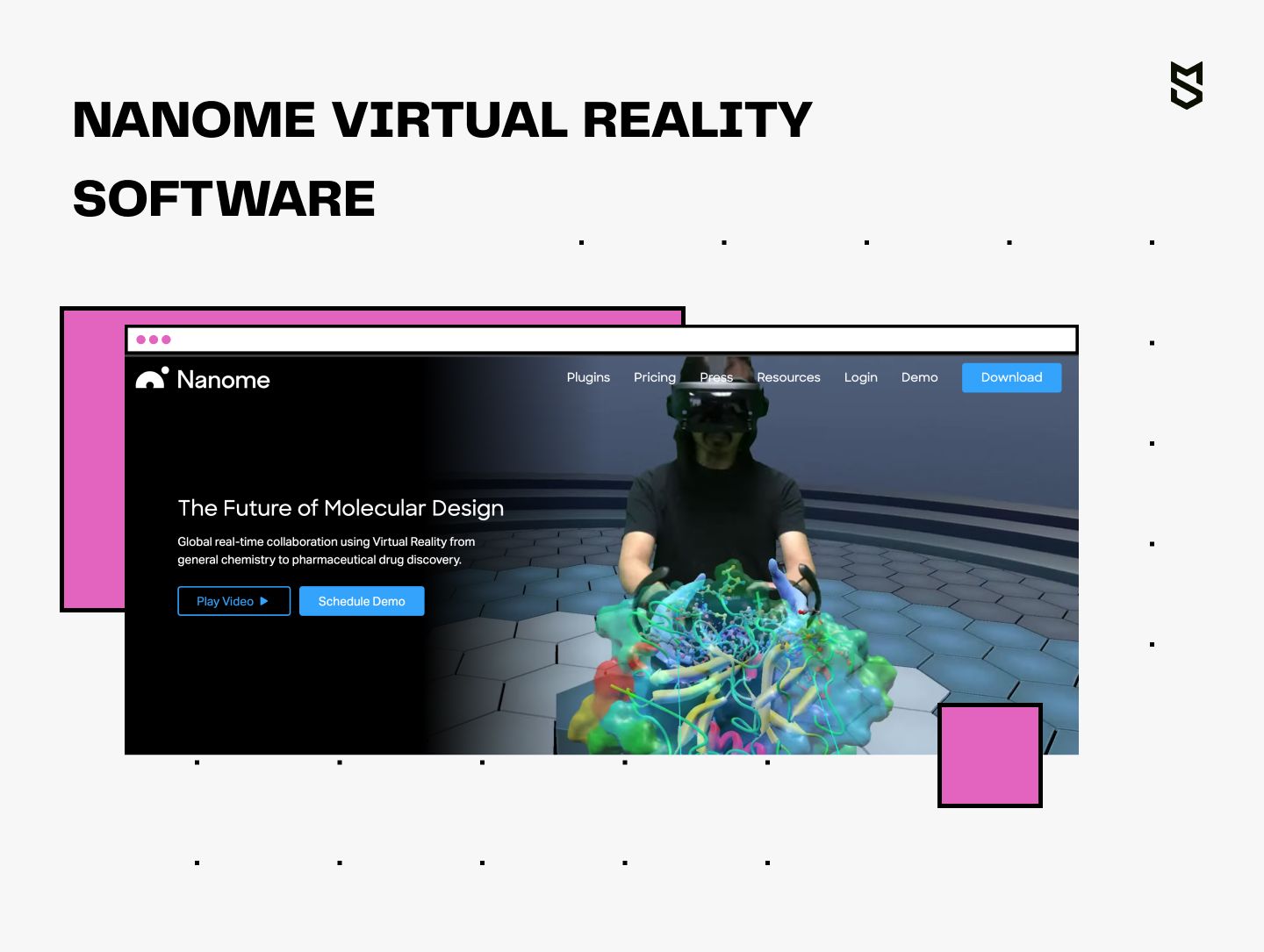
AI and VR, especially when involving users’ active participation, is extremely helpful in making the learning process engaging and effective.
UI/UX design for an e-learning platform
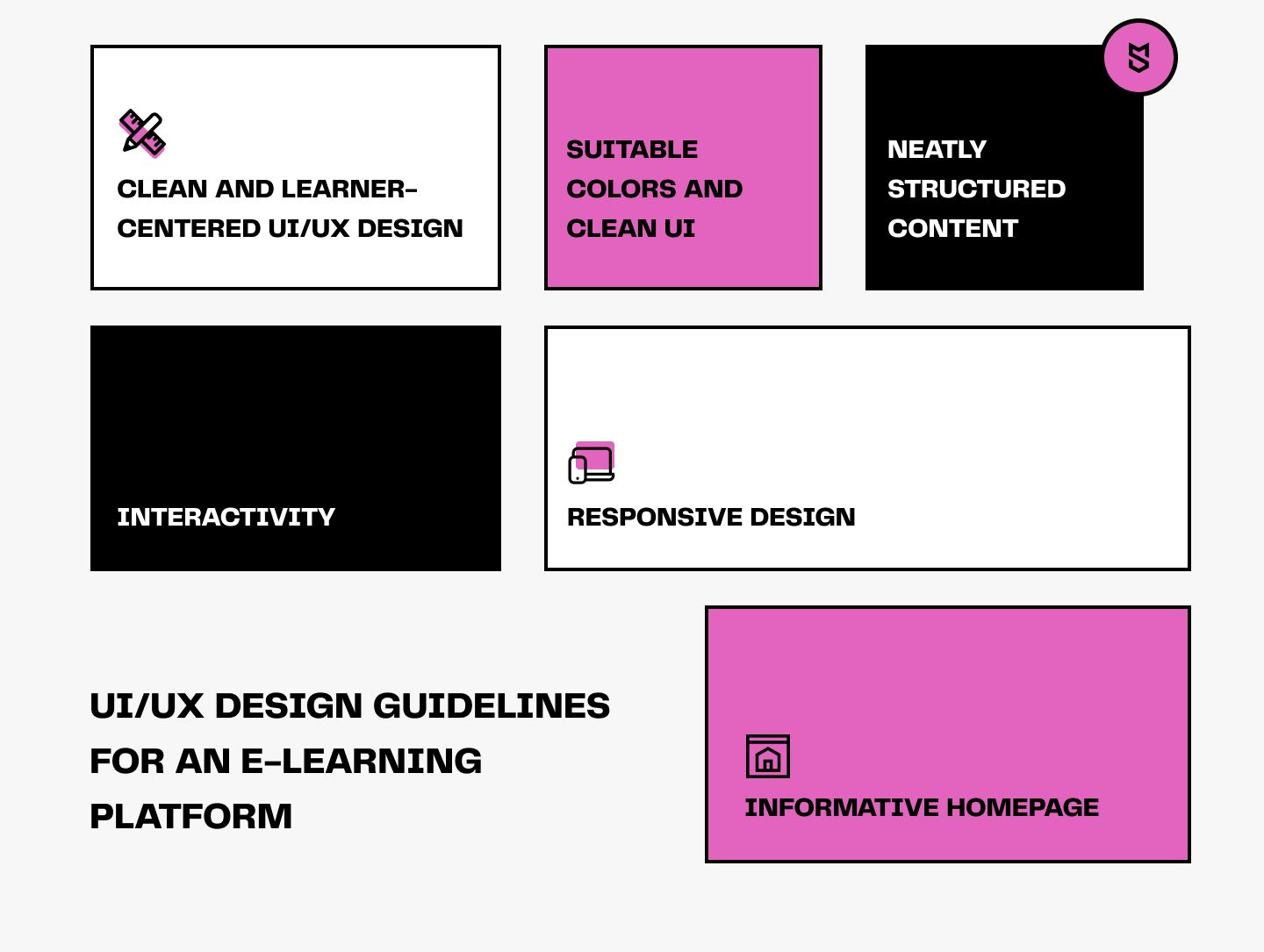
At this point, the key task is fitting the above-mentioned functionality into an intuitive user interface and backing it up with a positive user experience. Here are some rules to follow when developing an e-learning platform design.
Clean and learner-centered UI/UX design
When using the platform, students should focus only on educational objectives, not the navigational issues. Since the goal of the platform is to help users learn new things, every website element should serve a purpose. This means avoiding obtrusive sections, buttons, and so on. Remember that the website design should help users continue their learning journeys, not distract them.
Suitable colors and clean UI
UI/UX designers recommend keeping educational platforms uncluttered, using calm colors, easy-to-read fonts, and sufficient amount of white space, which serves a visual relief function. Clear instructions and CTAs such as “Watch this video” or “Take a test” are also extremely effective.
The most popular color schemes to create e-learning platforms are orange and yellow as the colors of mental stimulation, calming blue and green, and white to balance the brights out. However, each case is different, and there is no one-fits-all solution. That is why Mind Studios team always conducts an all-encompassing research before making decisions regarding the user interface.
Neatly structured content
Since educational content is the essence of any e-learning platform, it should be presented in a way that allows users to clearly understand the sequence of the educational material.
The structure of content influences the way learners use the app, and for that matter, their inclination to continue using it. If the content is easy to scan, divided into small paragraphs or sections, the learning experience is more appealing to the user. It’s also advisable to make the titles as descriptive as possible so that the learners know exactly what the section is about and can easily find the information they need.
Interactivity
This part is crucial if you want the users to be truly engaged in the learning process, to concentrate better, and therefore achieve greater results. Interactive elements, gamification, and goal-driven design is what makes the learning process more effective.
Responsive design
Users should be able to get the same experience regardless of the electronic device they use. In other words, your UI/UX should be responsive and device-friendly, since the prospective learners might use it both at home in front of their laptops or with their smartphones while commuting to work.
Informative homepage
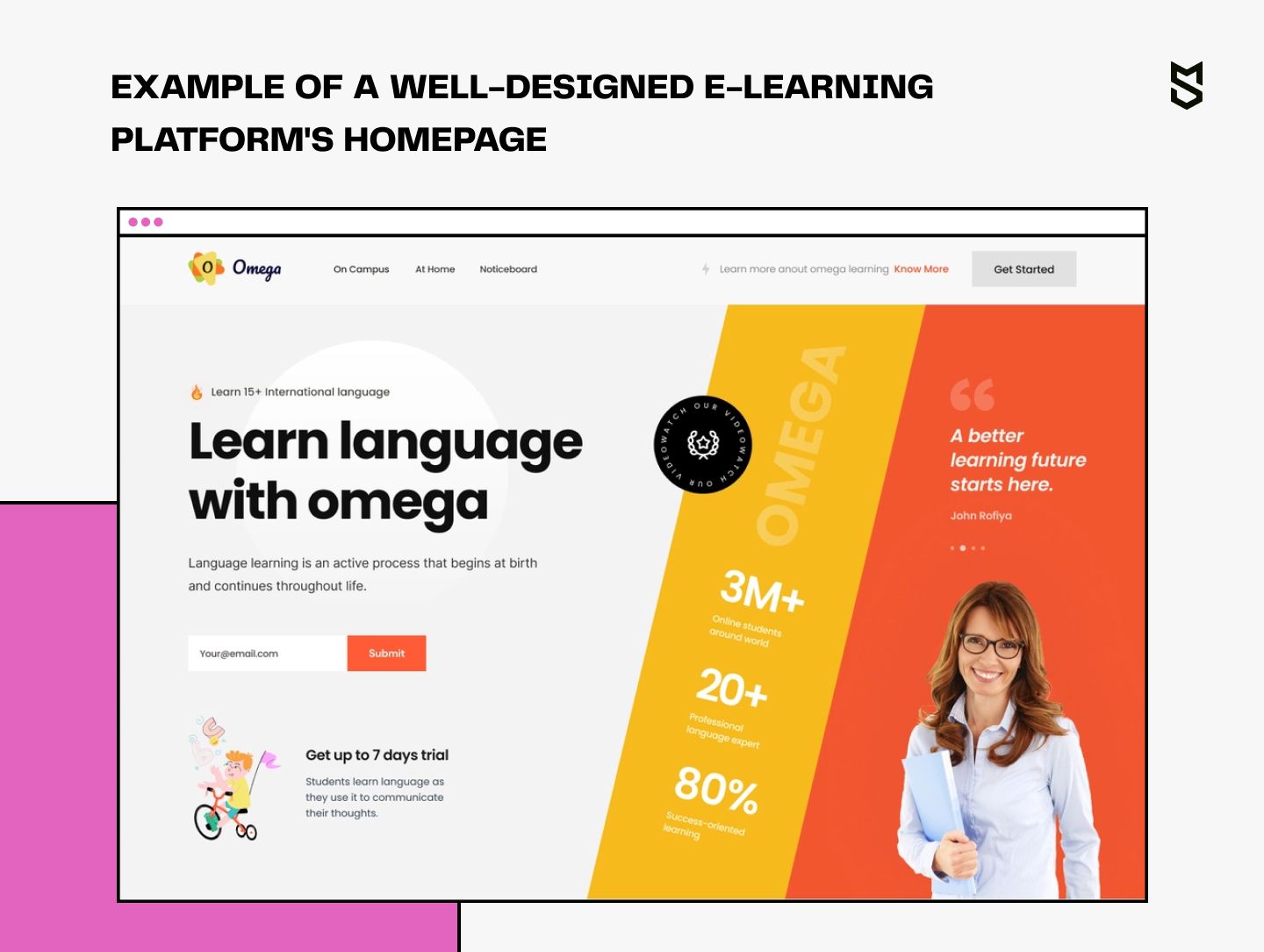
[Source: Dribbble]
In addition to general design solutions, we would like to point out the vital importance of homepage design. 94% of a user’s first impression of a website is design-related, and the homepage is the first one to reveal your platform’s vibe and value. Here’s a list of elements that can help you hold users’ attention and motivate them to continue exploring the website:
- Statistics
The number of students who’ve completed the course on your platform, brands using your software to train employees — such statistics will likely sway the decision in your platform’s favor. - A demo video of how the platform works
74% of users decide to buy software or download an app after watching a demo video. This approach works with digital education field as well. - Real reviews from customers
Publishing authentic reviews, even the ones with improvement suggestions, is one of the best ways to build trust and encourage word-of-mouth promotions. - Clear and motivating CTAs
Power your homepage with engaging CTAs, motivating users to test your platform, subscribe to a free trial period, etc.
Now it’s time to find out how to start an online learning platform.
How to develop an e-learning website
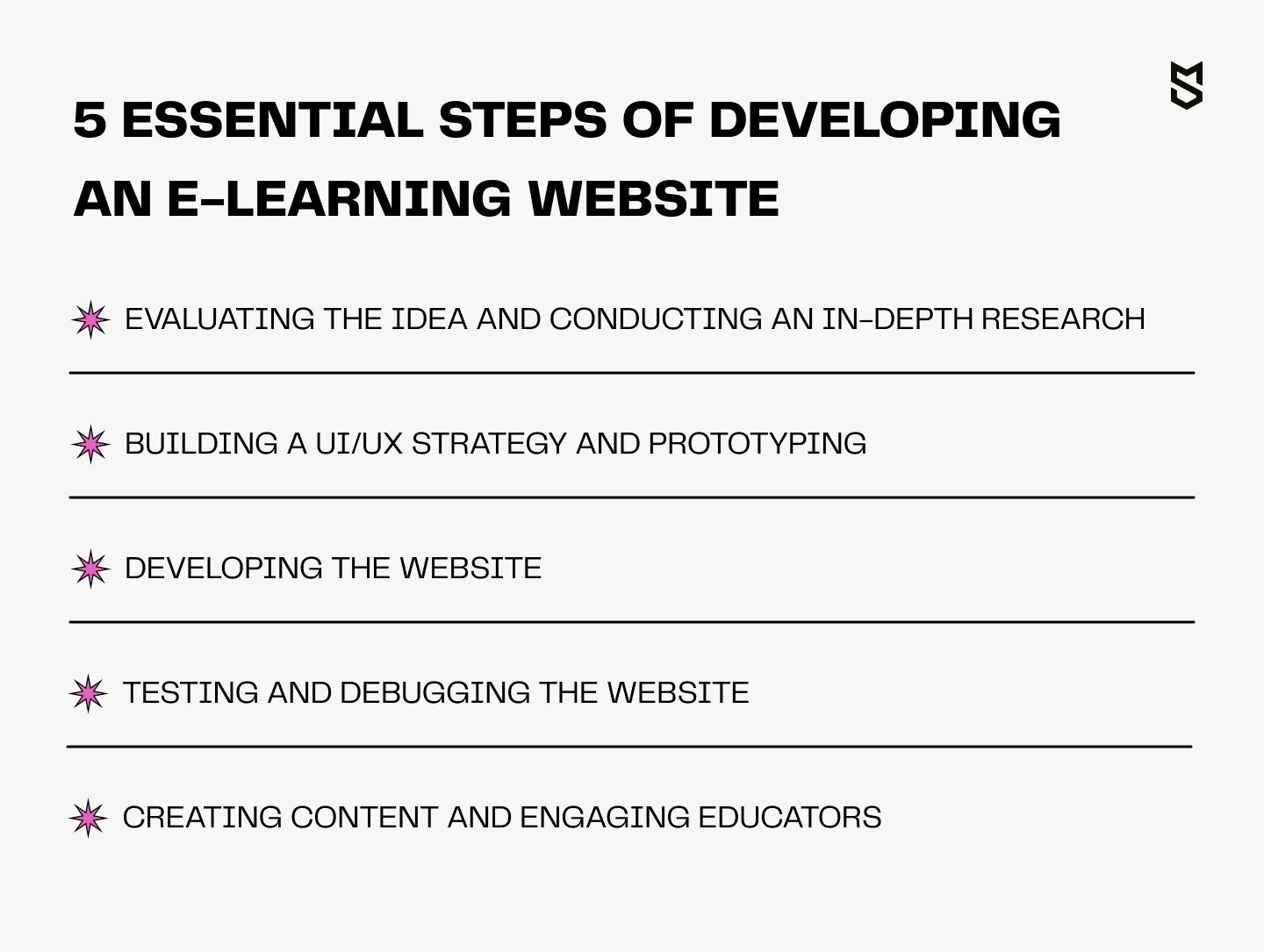
Here are the 5 essential steps that will help you get a more profound understanding of how to develop an e-learning portal.
1. Evaluating the idea and conducting an in-depth research
42% of startups fail because there’s no real market need for their product. This is why you should make sure your idea is the one that learners are waiting for before making the final decision to develop your own e-learning platform. To validate your idea and analyze the market, you may use proven approaches such as PEST, SWOT, the Five Forces Model, and focus groups.
This stage also includes communicating with prospective users and forming user personas. As a result, you will be able to define the type of your e-learning platform and the main pain points it is going to solve for the learners.
2. Building a UI/UX strategy and prototyping
At this point, the team will work on defining the main features the website will have, as well as draw screens, and transform them into mockups. After the client approves the concepts, they will be able to develop high-fidelity UI/UX prototypes — final mockups of each website page.
3. Developing the website
Here, the development team is taking the job over to transform the prototypes into a real website with real data and functioning features. As a rule, for the first release our team is ready to present the MLP (Minimum Lovable Product), which is a functional and well-designed version of the website.
You can find out more about the difference between MLP, MVP and MMP in our article.
After presenting the MLP, comes polishing the product and making necessary adjustments.
4. Testing and debugging the website
We’re almost there. This is the part where a quality assurance team makes sure every interaction with the website is flawless. If there are any bugs, they let the eLearning platform development team know what needs to be fixed.
5. Creating content and engaging educators
The content quality of the platform is just as important, if not more so, as its design and technical features. If you’re going to create content independently, make sure it’s relevant to your audience. Don’t forget to make the content diverse by adding text, audio, video, graphic, and gamified content.
If, on the other hand, you intend to build an eLearning website for other educational content creators, make sure those who manage their courses are reputable educators. Surely, you don’t have to invite celebrities to become a popular website. But validating tutors by checking their certificates is necessary to ensure the platform’s credibility.
To complete all these steps successfully, you will need to find a skilled website development team you can rely on. In the following sections, we will talk about the technology behind online education website development and specialists that are involved in the process.
E-learning platform tech stack
Depending on the type of e-learning platform you choose to build, every development team might come up with different technology solutions to implement it. At Mind Studios, the standard tech stack for building an online educational website looks like this:
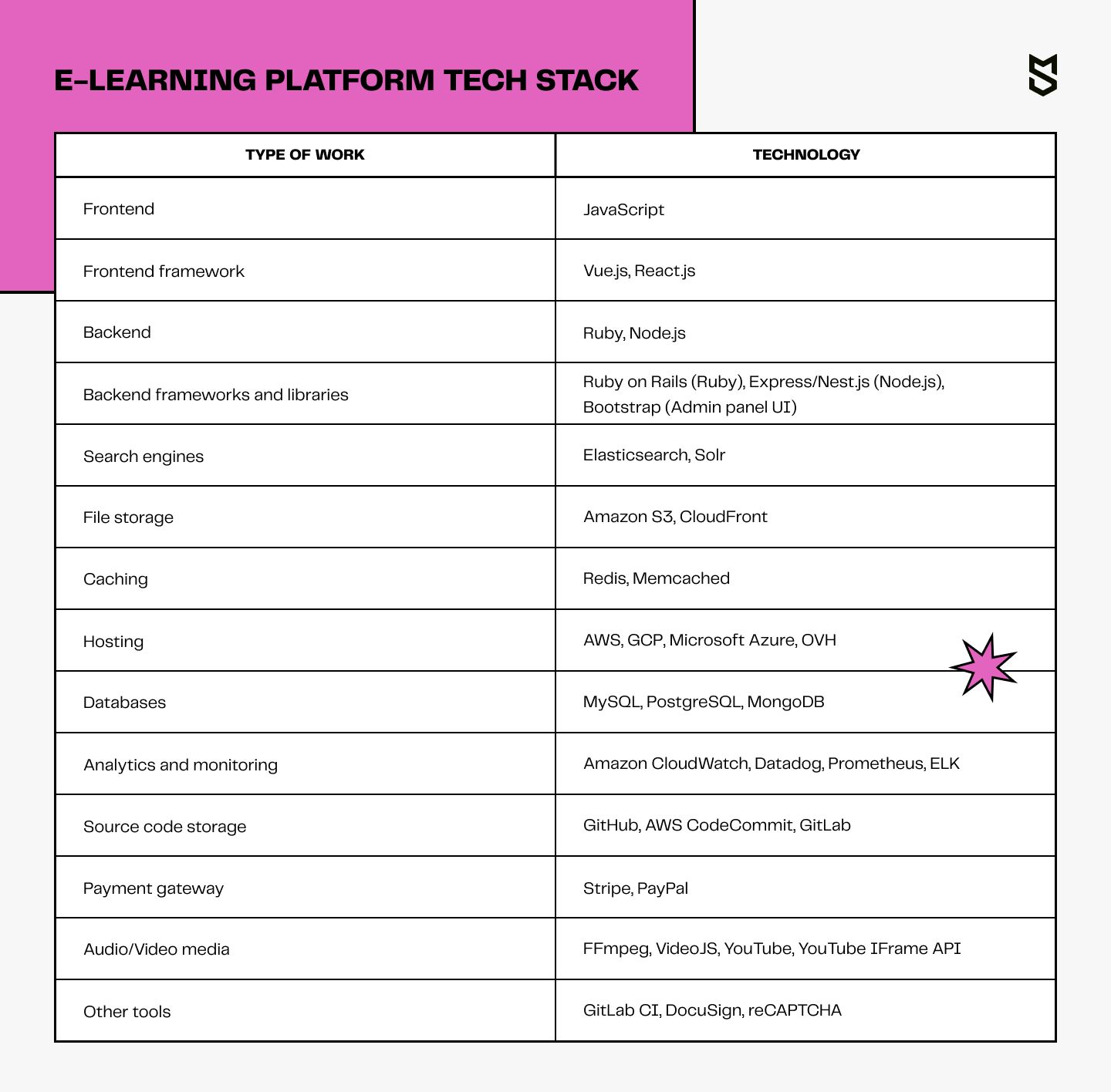
How much does it cost to build an e-learning website?
Since there are numerous types of educational websites, each idea is unique in terms of resources needed to implement it. On average, the cost to develop an e-learning platform may reach $86,000. However, your final price will be influenced by numerous factors, including:
- the type of e-learning platform
- the complexity of the design and the number of features
- the location of your development team
The e-learning platform development team
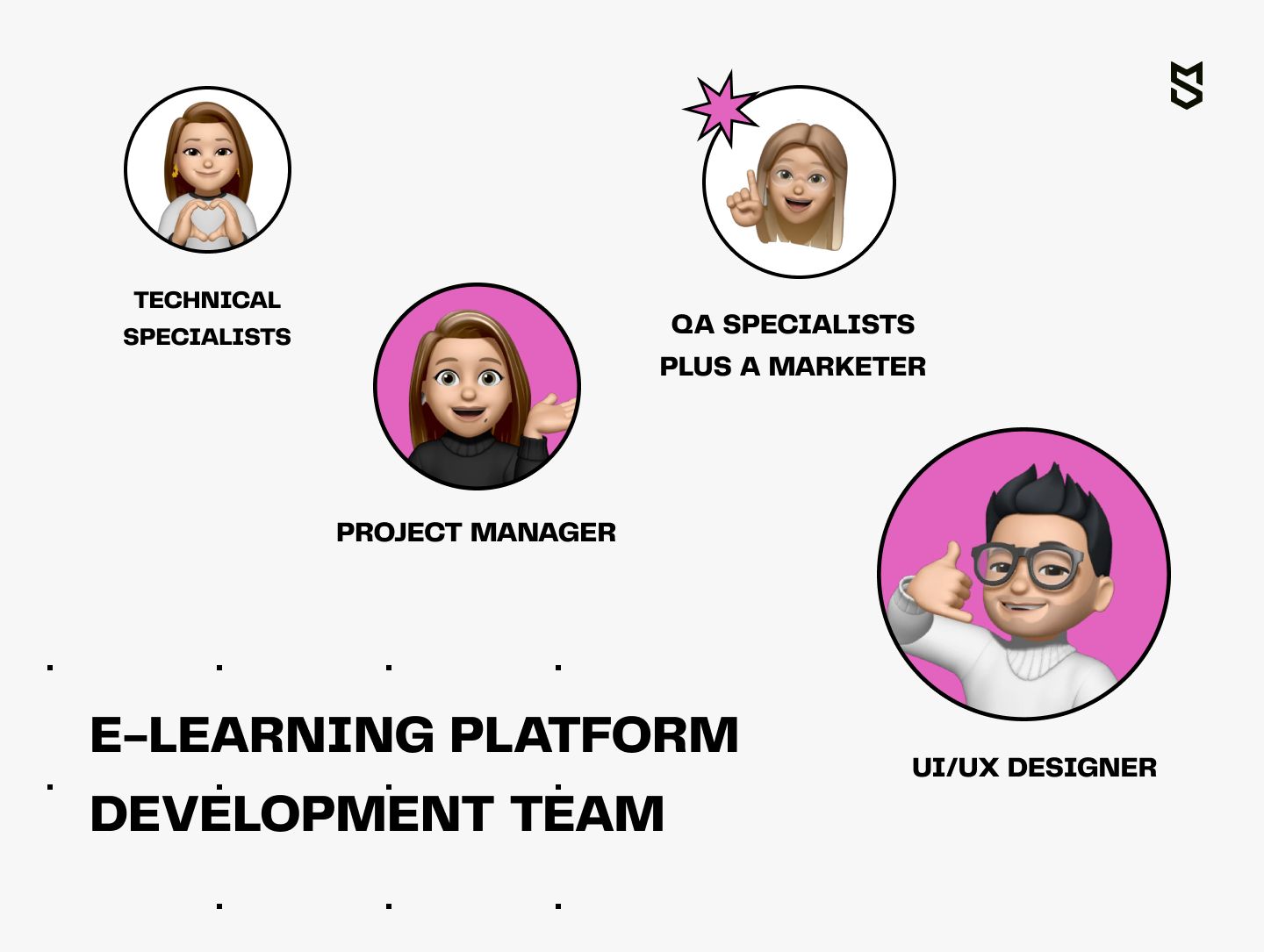
Whether you decide to hire an outsourcing company or go with in-house specialists, here is how your e-learning platform development team will look like:
- 1 project manager
- 1 UI/UX designer
- 1–2 technical specialists (frontend/backend developer)
- 2–3 QA specialists
- 1 marketer (optional)
The final price directly depends on your development team’s location and their hourly rates. For example, the cost for web application development services will be:
- $150/hour for a team located in the US
- $70/hour for a team located in Western Europe
- $45/hour for a team located in Eastern Europe
Here’s our take on the time necessary for developing an online learning platform:
- Business analysis and creating a specification — 96+ hours
- UI/UX design — 168+ hours
- Front-end development — 480+ hours for an MVP with the most essential features
- Backend development — 520+ hours
- Quality assurance / Project management— 260+ hours
In addition, the final price will be influenced by the technical complexity of your solution, since hard-to-implement features will take longer to create and might need more experienced specialists. Development itself is the most time-consuming stage.
In Mind Studios’ experience, it may take 1,524 to 2,080 hours to develop a custom e-learning website and cost $68,580 to $93,600.
E-learning development mistakes to avoid
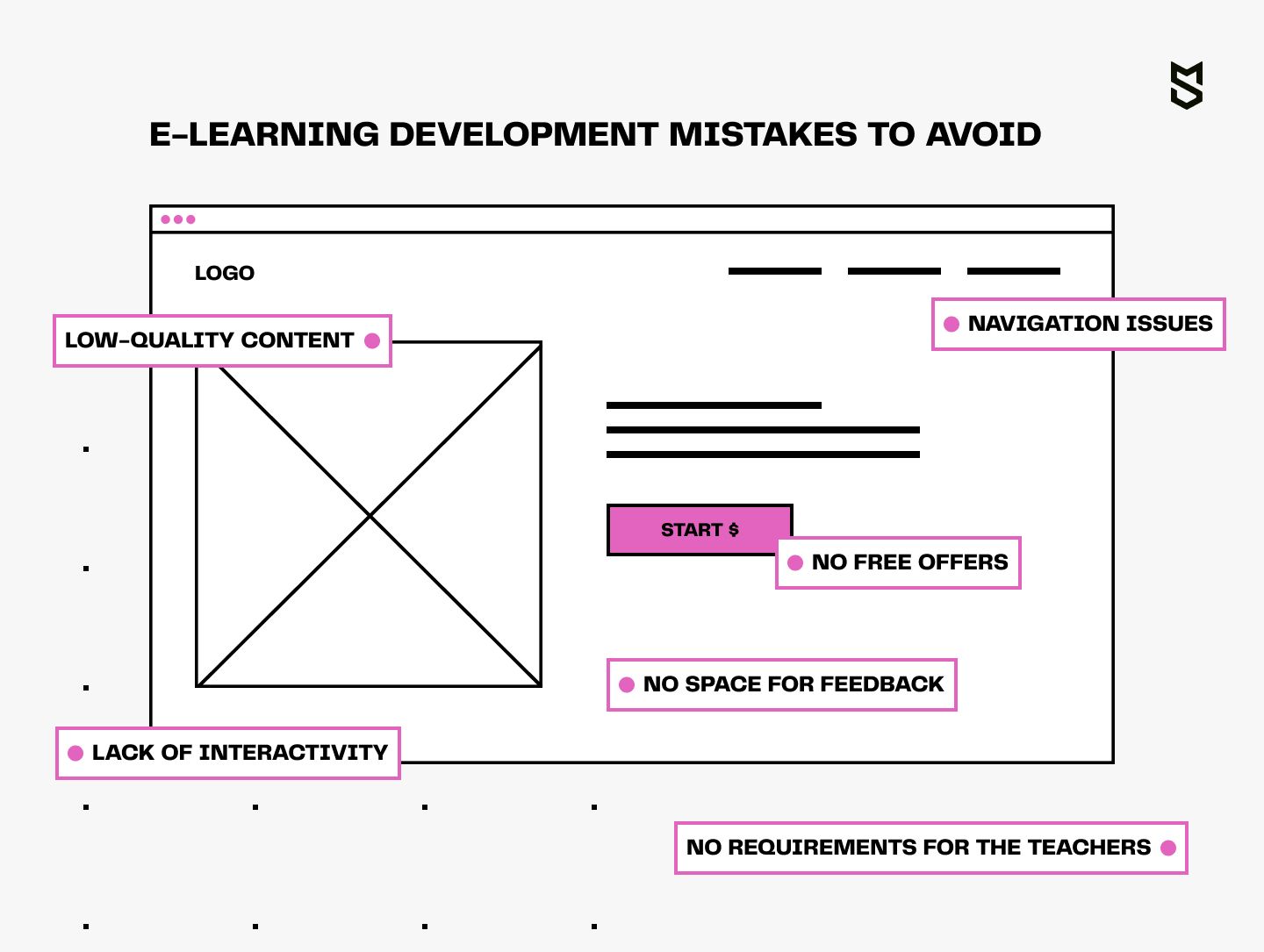
Developing an e-learning platform is a significant investment. However, it’s possible to do everything right from the first attempt and therefore decrease cost and time for product launch. We’ve made a list of common mistakes to avoid during online learning platform development.
Low-quality content
The relevance of your content, its structure, credibility, and effectiveness for students are key to your platform's success. Even the most advanced design and innovative features cannot make your website popular if the quality of educational content is poor.
Navigation issues
Online education platforms always contain large volumes of information for compulsory and additional study. Users should be able to quickly find the section they need and focus on studying instead of trying to understand how the platform works.
No space for feedback
If you’re creating a platform for teacher-student interactions, then teachers should be able to give students feedback on their progress and mistakes. Students, on the other hand, might want to share their opinion on the teaching methods and other aspects of the educational process. Besides, all users should be able to share their impressions of the user experience with you.
No requirements for the teachers
If your platform is an intermediary between students and teachers, then checking the teacher’s qualifications will lead to students receiving better educational content.
Lack of interactivity
Students’ engagement is one of the top reasons why companies decide to invest in digital education technologies. Interactivity and gamification are the best ways to engage users of any age. Moreover, this is what can help user to study more effectively when they have to process large amounts of information. Among the features that might be useful here are animations, videos, dialogue simulations, gamified quizzes, and tests.
No free offers
Before deciding whether to subscribe or purchase a course, students usually chose platforms where they can first check the quality of the educational content for free. Therefore, a trial period or other free offers are beneficial in the long run.
Conclusion
Hopefully, by this point, you have a fundamental understanding of how to create an online learning platform. However, each idea is unique and therefore requires custom solutions.
Whether you intend to build a language-learning website, a tutoring platform, an onboarding tool for businesses, or something entirely new — you are welcome to book a free consultation with Mind Studio’s business development consultant.
Together, you will dig into the specifics of your idea for an e-learning website and discuss ways to make it a success.

